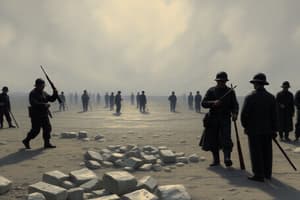Podcast
Questions and Answers
What was the primary advantage of the Short Magazine Lee Enfield Rifle Mk III during the Great War?
What was the primary advantage of the Short Magazine Lee Enfield Rifle Mk III during the Great War?
- It had a longer range compared to all other rifles.
- It was lighter and easier to carry than other rifles.
- It had increased accuracy and range, allowing effective use at a distance. (correct)
- It could shoot more rounds per minute than any machine gun.
What role did zeppelins play during the Great War?
What role did zeppelins play during the Great War?
- They served as bomb carriers and for scouting enemy positions. (correct)
- They provided support for naval operations.
- They were primarily used for transporting troops.
- They were used to drop leaflets for psychological warfare.
During the Battle of Tannenberg, what mistake did the Russian commander make?
During the Battle of Tannenberg, what mistake did the Russian commander make?
- He did not send enough reinforcements.
- He failed to utilize artillery effectively.
- He ignored warnings from his pilots regarding enemy movements. (correct)
- He underestimated the strength of the German forces.
Which weapon caused the highest number of casualties on the Western Front during the Great War?
Which weapon caused the highest number of casualties on the Western Front during the Great War?
What was a commonly favored close-combat option for soldiers in the trenches instead of using a bayonet?
What was a commonly favored close-combat option for soldiers in the trenches instead of using a bayonet?
What was a significant advantage that Austria-Hungary had over Italy in the battles of Isonzo?
What was a significant advantage that Austria-Hungary had over Italy in the battles of Isonzo?
What role did flamethrowers play in the Battle of Verdun?
What role did flamethrowers play in the Battle of Verdun?
Which of the following statements is true regarding the Vickers machine-gun?
Which of the following statements is true regarding the Vickers machine-gun?
What was a common technique used by soldiers to keep the Vickers machine-gun cool during extended fire?
What was a common technique used by soldiers to keep the Vickers machine-gun cool during extended fire?
Which of these characteristics made the Lewis Gun popular in the British Army?
Which of these characteristics made the Lewis Gun popular in the British Army?
Flashcards
Air-based weapons of WWI
Air-based weapons of WWI
Airplanes and zeppelins were used to drop bombs and scout enemy territories. This marked the first major use of large air-based carriers for bombs in warfare, resulting in significant civilian casualties.
Battle of Tannenberg significance
Battle of Tannenberg significance
A German victory in 1914 that stopped the Russian advance into German territory. Airplane reconnaissance was crucial to both sides. The Russian army's failure to utilize this intelligence was a costly mistake.
Rifle's impact in WWI
Rifle's impact in WWI
Rifles, with improved accuracy and range, were the most common weapon. Soldiers could effectively inflict damage from further away. The British Short Magazine Lee Enfield was a common model.
Artillery's destructive role in WWI
Artillery's destructive role in WWI
Signup and view all the flashcards
Bayonet role and impact
Bayonet role and impact
Signup and view all the flashcards
Paris Gun
Paris Gun
Signup and view all the flashcards
Isonzo Battles
Isonzo Battles
Signup and view all the flashcards
Flamethrower (WWI)
Flamethrower (WWI)
Signup and view all the flashcards
Machine Gun (WWI)
Machine Gun (WWI)
Signup and view all the flashcards
Vickers Machine Gun
Vickers Machine Gun
Signup and view all the flashcards
Study Notes
Air Warfare
- Airplanes and zeppelins were used for the first time in large-scale bombing campaigns.
- Zeppelins were used for bombing and reconnaissance.
- Airplanes were used to scout enemy territory.
- The Battle of Tannenberg was a German victory, stopping Russian advances.
- The Russian commander mistakenly ignored pilot warnings.
Rifles
- Rifles were the most common weapon.
- Improvements in rifle design led to more accurate shooting at greater ranges.
- The British Short Magazine Lee Enfield Rifle Mk III had a maximum range of 2,280 meters and effective range of 550 meters.
- A well-trained infantryman could fire 15 rounds per minute.
Artillery
- Artillery was the most destructive weapon on the Western Front.
- Artillery could rain down high explosives, shrapnel, and poison gas.
- Artillery could destroy troop concentrations and fortifications.
- The Battle of the Somme saw almost 1.8 million shells fired in a week.
- The German Paris gun shelled French cities from a long distance.
Tanks
- Tanks were a new military technology.
- Initial tanks were called "landships" and had mechanical issues.
- Tanks were used in the Battle of Cambrai in 1917.
- Tanks were used to cross barbed wire and protect soldiers against machine gun fire.
Chemical Warfare
- Chemical weapons were a significant new weapon.
- Gases such as chlorine were used.
- Mustard gas was also used.
- Chemical weapons caused significant casualties and injuries.
Machine Guns
- Machine guns were one of the deadliest weapons of the war.
- The Vickers machine gun was reliable and could fire over 600 rounds per minute.
- Machine guns were effective in fixed positions.
Grenades
- Grenades were ideal for trench warfare.
- Grenades could be thrown into enemy positions.
- Grenades could be dangerous if not handled correctly around trenches.
Submarines
- Submarines, called U-boats by the Germans were used.
- Submarines were used to attack enemy ships.
- Submarines played a key role in naval battles.
- Battle of Jutland featured large numbers of battleships, one of the largest naval battles in history.
Studying That Suits You
Use AI to generate personalized quizzes and flashcards to suit your learning preferences.




